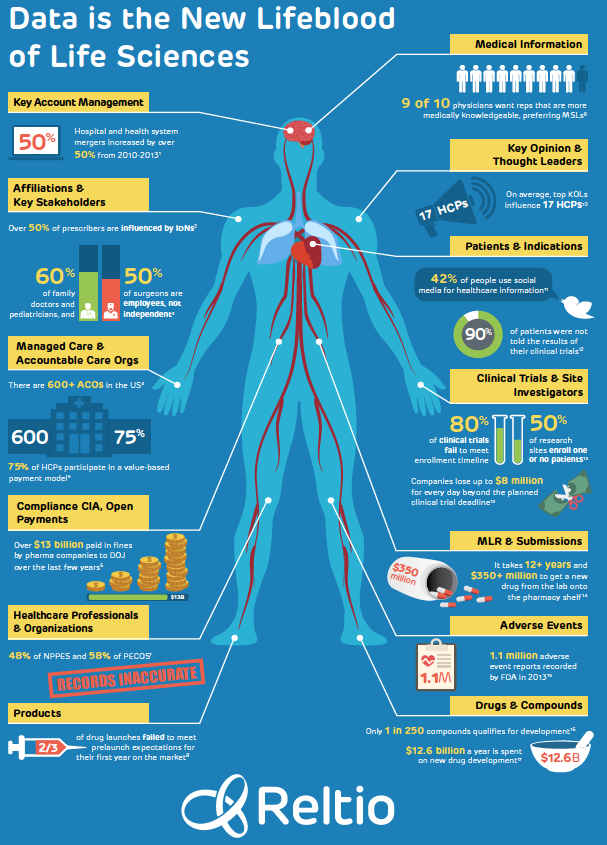 Often when I feel unwell and have to visit a doctor, I expect that by the end of the consult I’ll walk out of the office with a prescription. The cure aligns with the symptoms I’m exhibiting to help me feel better, until my body can heal itself. Interestingly, that’s kind of how many data management and related technologies work as well. Point solutions target a specific issue, so companies can carry on with their activities. The difference is, that unlike a human body, there’s no self-healing going on with aging systems and bad data without some form of intervention.
Often when I feel unwell and have to visit a doctor, I expect that by the end of the consult I’ll walk out of the office with a prescription. The cure aligns with the symptoms I’m exhibiting to help me feel better, until my body can heal itself. Interestingly, that’s kind of how many data management and related technologies work as well. Point solutions target a specific issue, so companies can carry on with their activities. The difference is, that unlike a human body, there’s no self-healing going on with aging systems and bad data without some form of intervention.
Bad data is like a virus attacking the nervous system of a pharma company. Unreliable data can lead to incorrect insights and assumptions, which leads to poor or inefficient actions. Simple facts such as incorrect or expired HCP licenses could mean violation of sample compliance rules. Erroneous association of speaker payments or lunch expenses could mean an HCP gets labeled, via the open payments CMS website, for activities that they never performed.
Reputation, customer experience, and satisfaction are just the tip of the iceberg. Billions of R&D and commercial operation dollars are at stake when it comes to efficient clinical trials and drug launches.
Suffice it to say data are the lifeblood of life sciences, and everyone is looking to become more data-driven.
Early Diagnosis Pointed to Customer Master Data
Nearly 10 years ago, technology dictated that poor data quality be treated through a discipline called customer master data management (MDM). This comprised bringing together HCP/HCO profiles across siloed applications, such as CRM, ERP, and financials to get a consolidated, cleansed view of name, address, and other attributes. Companies that could afford the significant infrastructure, resources, and skills required to do this, then created identifiers back to source applications so that they could bring together associated transactions, such as scripts written, speaker payments, and so forth to get a 360-view of all the physician’s activities. Armed with this information, companies could then generate more accurate reports for compliance, increase the efficiency of their sales and marketing teams through more accurate contact data, and get a better understanding of their customer.
Everything Got More Complicated and Related
While this served as a reasonable Band-Aid to the problem, the real 360-view has gotten much more complex. HCPs are increasingly affiliated with IDNs, have multiple places of business, and are influential in more ways than just simply writing and recommending scripts. Some are key opinion leaders, publishers of thought leadership pieces. Others sit on formulary committees with significant sway, and an eagle eye on pharmacovigilance. The once expensive on-premise customer master that treated the data quality symptoms of a pharma company is now turning out to be just a set of earplugs blocking out the noise of the real challenges that await.
Getting to the Heart of the Problem
 Every company in the industry knows that reliable HCP/HCO data are needed, but affiliations, hierarchies, and relationships between people, products, places, and organizations must now be captured, modeled based on the real world, constantly updated, and made reliable. People come in different flavors beyond HCPs. Patient data and profiles are now the heart of many a pharma focus in a quest for patient-centricity.
Every company in the industry knows that reliable HCP/HCO data are needed, but affiliations, hierarchies, and relationships between people, products, places, and organizations must now be captured, modeled based on the real world, constantly updated, and made reliable. People come in different flavors beyond HCPs. Patient data and profiles are now the heart of many a pharma focus in a quest for patient-centricity.
If a customer master is insufficient, as is a standalone product master, what is the cure? MDM of all types and domains within a single platform is a good start. Moving to the cloud is also good as it increases agility, reduces cost and democratizes access to clean, reliable data for company of all sizes. But that is still an evolutionary treatment of a problem that has wider repercussions. Big data — transactions, interactions, social, machine-generated — threatens to overwhelm the senses and capacity of companies and their teams looking for the best insight and path forward. It would appear that continuing with even multi-domain MDM feeding siloed apps such as CRM and ERP, will only delay the inevitable. Luckily clues from consumer data-driven applications like Facebook and LinkedIn point to a cure.
Getting the Full Treatment
When you use LinkedIn today, you are shown content that’s relevant to you. You are given up-to-date statistics on your first-level connections, and the vast potential network at your fingertips. If you want to engage with someone you aren’t connected with, LinkedIn recommends the path you can take, through a shared connection’s introduction. LinkedIn also presents jobs that are relevant to your current profession, narrowing the millions of jobs down to those that you care about. It realizes the goals you have, and as a user that you are looking to network or find a new job, and it’s there to help you.
If you log into LinkedIn as a recruiter, you get a different view, you’re able to easily filter, segment the skills and profiles of candidates you seek, and reach out to them. As a marketer or sales professional, you can leverage LinkedIn to manage and track your leads, with the ability to collaborate with your peers and to strategize on how to handle accounts. Finally, LinkedIn has data quality. It’s essentially self-governed, but also crowd enhanced through recommendations and endorsements. The value of data and facts are exponentially magnified beyond the simple accuracy of job experience, name, and contact information. All of this is built on top of a single pool of data that continues to grow into the hundreds of millions, at perfect scale and performance.
By way of contrast, legacy enterprise process-driven applications such as CRM act as recording devices, not offering any recommendations or suggestions on what to do next based on a users role and goals. In fact, if you’re in marketing, you can’t really leverage the same data that sales uses in CRM for your marketing campaigns without a painful integration or transfer of data to a separate data warehouse. LinkedIn on the other hand, seamlessly delivers an appropriate mobile-enabled and data-driven application that matches your role and goals, from the same pool of data.
A Transfusion When You Need It
What makes the creation of enterprise data-driven applications more complex than LinkedIn is the need to incorporate third-party sources to augment and enrich data. Traditionally this has been a cumbersome, resource intensive IT back-office process. Today, data-as-a-service makes that pill much easier to swallow, with direct connectivity between applications and third-party data. Pre-integrated and pre-aligned for one-click onboarding, frontline business users can shop for data like they shop on Amazon.
Become a Healthier, Agile Enterprise Over Time
The good news is that getting to enterprise data-driven applications is not like having a brain transplant. It starts with a modern data management platform that embodies the best of MDM, big data, data-as-a-service, analytics, and machine learning all in one. Upon which data-driven applications can be incrementally deployed to treat business symptoms in each part of an organization. The difference between apps of the past is that the data used to solve one challenge is now free to flow across the enterprise, and be used by other apps. Teams access data to meet their goals, with recommended actions to guide them that are ever improving through a closed loop that learns from its outcomes.
The next time a technology is proposed for your business symptom, enquire about the longer-term data-driven vision. That will ensure your entire company, not just your own organization, gets a positive prognosis. (PV)
Reltio delivers reliable data, relevant insights and recommended actions so companies can be right faster. Reltio
Cloud combines data-driven applications with modern data management for better planning, customer engagement and risk management. Reltio enables IT to streamline data management for a complete view across all sources and formats at scale,
while sales, marketing and compliance teams use data-driven applications to predict, collaborate and respond to
opportunities in real-time. Companies of all sizes, including leading Fortune 500 companies in healthcare and life
sciences, distribution and retail rely on Reltio. For more information visit reltio.com


















